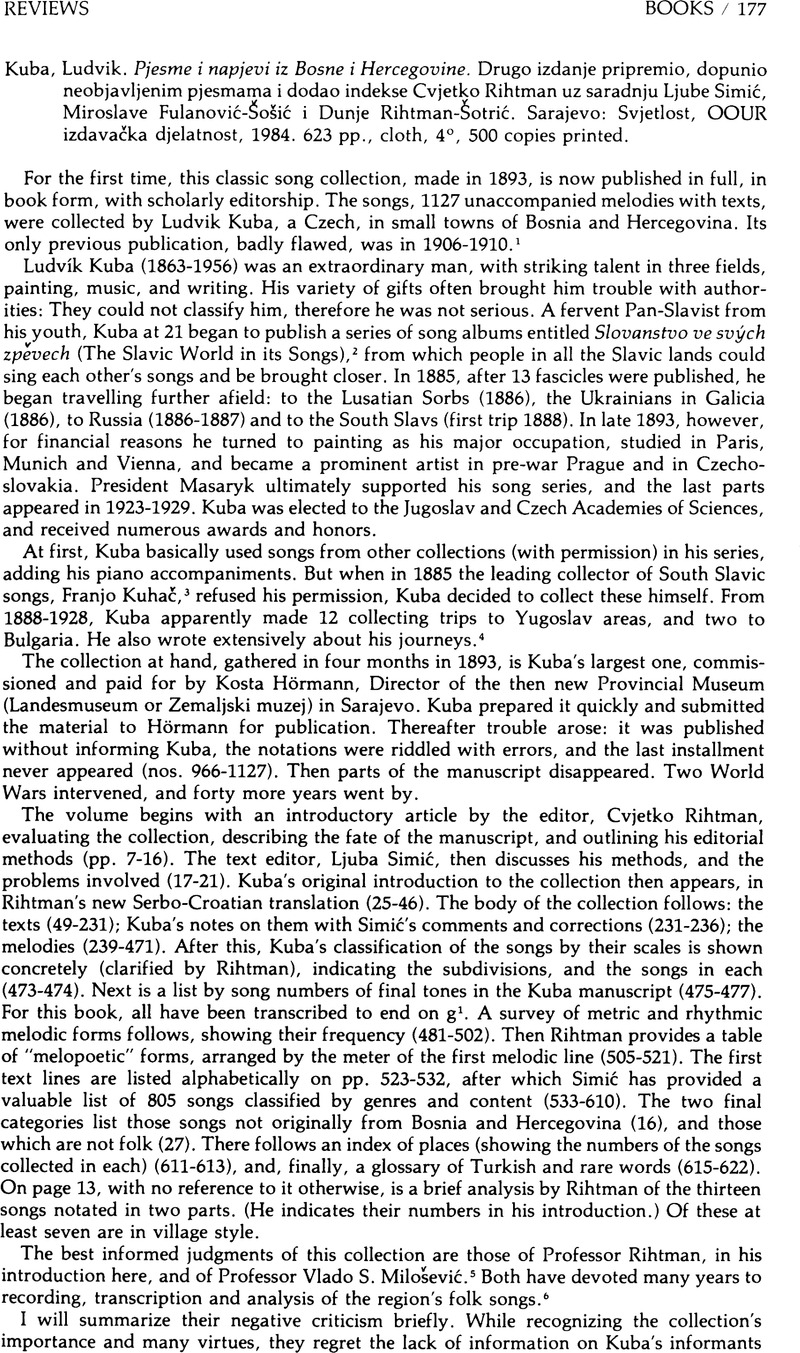No CrossRef data available.
Published online by Cambridge University Press: 07 March 2019

1. Glasnik Zemaljskog muzeja u Bosni i Hercegovini. (Sarajevo.) XVI (1906), XVII (1907), XXI (1909), XXII (1910).Google Scholar
2. Slovanstvo ve svých zpêvech. I. Písnê ĉeské (Czech), 1884-1888. II. Písnê moravské (Moravian) 1888. III. Písnê slovenské (Slovak) 1888. IV. Písnê polské (Polish) 1887. V. Písnê luzické (Lusatian Sorb or Wend) 1885-1887. VI. Písnê ruské (Russian, including Great Russian, Ukrainian and Belo-russian) 1885-1888. VII. Písnê jihoslovanské (South Slavic) 1890-1929.Google Scholar
3. Franjo Ksaver Kuhaĉ (1834-1911) collected songs at his own expense 1857-1869 in Croatia, Vojvodina, Istria, Dalmatia, Slovenia, Bosnia, Serbia, Montenegro, Macedonia and Bulgaria. In his published collection, Juzno-slovjenske narodne popievke, 4 vols. 1878-1881 (vol. 5, 1941), there are 2000 songs with melodies and piano accompaniment. The publication nearly bankrupted him, which probably explains his refusal to Kuba.Google Scholar
4. Cf. in German, Kuba, L., “Gesang und Musik” in Die Oesterreichisch-ungarische Monarchie in Wort und Bild, vol. 14. Bosnien und Hercegovina. Vienna 1901, 376-390. Also his “Einiges über das istro-dalmatinische Lied”, Bericht des III. Kongress der internationalen Musikgesellschaft, Wien, 1909. Vienna 1909. His chief studies on Slavic folk music, with over fifty of his short articles, mostly on his song collecting, with melodies and his illustrations, are published in L. Kuba. Cesty za slovanskou písní 1885-1929, Prague 1933-1935. 2 vols. 2nd ed., Prague 1953, bound in one volume. See review of the latter in JIFMC VII (1955); also, his obituary in JIFMC X (1958).Google Scholar
5. Vlado Miloŝević. “Melografski rad Ludvika Kube,” Razvitak (Banja Luka 1940), No. 6. Reprinted in Putevi, year XXII (Banja Luka 1976), No. 5, 479–487. See also the article by the late Director of the Ethnographic Museum in Belgrade: Slobodan Zeĉević. “Ludvik Kuba,” Zvuk No. 62 (Belgrade 1964), 162-173. Also Dizdar, Hamid. “Ĉeski melograf i slikar Ludvik Kuba i njegov rad u Bosni,” Glasnik arhiva i Druŝtva arhivskih radnika Bosne i Herzegovine, year 1964-1965, vol. IV-V (Sarajevo 1965), 229-239.Google Scholar
6. See their entries in the bibliography of the article on folk music of Bosnia and Hercegovina, by Rihtman, in the New Grove Dictionary of Music and Musicians (1980), vol. 20, 593–594.Google Scholar
7. cf. Bartók, Béla and Lord, Albert. Serbo-Croatian Folk Songs. New York 1951, p. 34. This statement is alluded to by Rihtman. Kuba discusses his organization of his melodies by scale type in his introduction. The actual subdivisions and the songs in each one are indicated in the new edition only in an appendix, pp. 473–474.Google Scholar